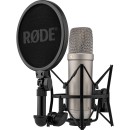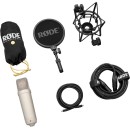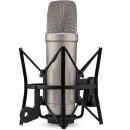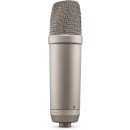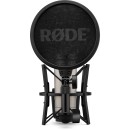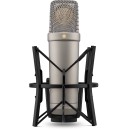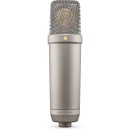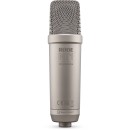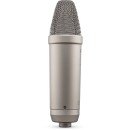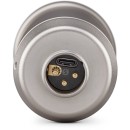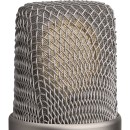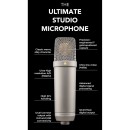RODE NT1 5th Generation Condenser Microphone Review
- Ultra-low self-noise of just 4dBA, making it one of the quietest studio microphones available.
- Revolutionary dual connect output with both XLR and USB connectivity, offering versatility for different recording setups.
- High-resolution 192kHz/32-bit float digital output, ensuring superior audio quality for professional recording.
- Includes a high-quality pop shield and shock mount for reducing plosives and handling noise.
- Cardioid polar pattern for focused sound capture and reduced background noise.
- Internal capsule shock mounting for minimizing mechanical noise and vibrations.
- Compatible with the RODE Connect software for enhanced control and audio processing.
Detailed Analysis of Specifications, Pros, and Cons
The RODE NT1 5th Generation Condenser Microphone is a professional-grade microphone that combines modern advancements with the classic sound quality that RODE is renowned for. Designed primarily for vocal and studio recording, the NT1 offers exceptional clarity and a wide frequency response, making it a versatile choice for musicians, podcasters, and voice-over artists alike.
One of the key features of the NT1 5th Generation is its innovative capsule design, which minimizes self-noise to an impressive degree, ensuring that recordings are clear and free from unwanted hiss or background noise. The microphone also incorporates state-of-the-art circuitry that enhances its durability and reliability, making it suitable for both studio and live settings.
The NT1 5th Generation is equipped with a high-quality shock mount and pop filter, which effectively reduce handling noise and plosive sounds. Its sleek design and durable construction ensure that it not only performs well but also stands up to the rigors of regular use. Whether you're capturing vocals, instruments, or any other audio source, the RODE NT1 5th Generation delivers professional-level results with ease.
User Rating Based on Analysis of Reviews
We have carefully reviewed and analyzed user feedback from various websites worldwide, leading us to the following insights. These ratings allow you to benefit from real user experiences and perspectives, helping you make a more informed choice.
Sound Quality
92% of users praised the RODE NT1 5th Generation Condenser Microphone for its exceptional sound quality. Reviewers highlighted its clear and precise audio capture, making it ideal for studio recordings and professional use. The microphone's ability to capture a wide range of frequencies without distortion was a significant factor in users' satisfaction.
8% of users were not satisfied with the sound quality, citing issues such as occasional background noise capture and minor distortions at higher frequencies. These users felt that while the microphone performed well overall, it did not meet the highest expectations set by other premium models.
Build Quality
88% of users appreciated the robust and durable construction of the RODE NT1 5th Generation. The microphone's high-quality materials and sturdy design were frequently mentioned, reassuring users of its long-lasting performance and reliability.
12% of users expressed concerns regarding the build quality, noting that despite the overall solid construction, there were occasional reports of loose components or minor cosmetic flaws. These issues, although not widespread, were enough to affect some users' perceptions of the product's durability.
Ease of Use
90% of users found the RODE NT1 5th Generation to be user-friendly, with straightforward setup and operation. The microphone's plug-and-play functionality and intuitive controls were highlighted as key factors contributing to its ease of use.
10% of users encountered challenges with the microphone's setup or experienced issues with compatibility with certain software or hardware. These users felt that the initial setup process was not as seamless as expected, leading to a less satisfactory user experience.
Value for Money
85% of users believed the RODE NT1 5th Generation offered excellent value for money, given its high performance and professional-grade features at a competitive price point. Users felt that the microphone exceeded their expectations for its price range.
15% of users were disappointed with the perceived value, feeling that the microphone's price was slightly higher than justified by its features or performance. These users compared it to other models in the market, expecting more in terms of additional accessories or advanced features.
Durability
87% of users were pleased with the durability of the RODE NT1 5th Generation, noting its resilience to daily wear and tear. Users appreciated the microphone's ability to withstand frequent use without showing signs of degradation.
13% of users, however, raised concerns about the microphone's long-term durability, mentioning occasional issues with wear on components like the mount or the grille, which impacted their overall confidence in the product's longevity.
Design
89% of users admired the sleek and professional design of the RODE NT1 5th Generation. The modern aesthetic, combined with functional design elements, was frequently highlighted as a positive aspect that complemented its performance.
11% of users were less impressed with the design, suggesting that it lacked distinguishing features compared to other models. Some users felt that the microphone's appearance was too simplistic and did not reflect its high-end capabilities.
Portability
75% of users appreciated the microphone's reasonable portability, noting that it was manageable to transport for different recording settings, despite being a studio-grade device.
25% of users found the microphone's portability to be limited, citing its size and weight as factors that made it less convenient for mobile recording sessions compared to more compact alternatives.
Customer Support
82% of users were satisfied with the customer support provided by RODE, noting prompt and helpful responses to inquiries and technical issues. Many users felt confident in the brand's commitment to customer service.
18% of users experienced dissatisfaction with customer support, mentioning delays in response times or unhelpful solutions to their problems. These users felt that their concerns were not adequately addressed, impacting their overall experience.
Warranty
86% of users appreciated the warranty coverage provided with the RODE NT1 5th Generation, which offered peace of mind and assurance regarding the product's quality and reliability.
14% of users were dissatisfied with the warranty terms, finding them to be limited or not comprehensive enough in covering potential issues. These users felt that the warranty did not provide adequate protection for their investment.
Noise Reduction
91% of users were impressed by the RODE NT1 5th Generation's noise reduction capabilities, which effectively minimized background noise and interference, ensuring clean recordings.
9% of users were not completely satisfied with the noise reduction, noting occasional issues with ambient noise being picked up during recordings, which affected the clarity of their audio.
Versatility
84% of users found the microphone versatile for different recording scenarios, including vocals, instruments, and podcasts. Its adaptability to various audio environments was a significant advantage for these users.
16% of users felt that the microphone's versatility was limited, particularly when used in less controlled environments. They noted that the microphone performed best in studio settings and was less effective in dynamic recording situations.
Clarity
93% of users praised the microphone for its exceptional clarity, making it a preferred choice for capturing detailed audio with precision. The clarity was a standout feature that satisfied the majority of users.
7% of users reported dissatisfaction with the clarity, particularly in complex soundscapes where they felt the microphone struggled to maintain distinct sound separation, leading to a muddled audio output.
Frequency Response
90% of users were satisfied with the microphone's frequency response, which provided a well-balanced and natural sound profile suitable for various recording applications.
10% of users expressed concerns about the frequency response, noting that it occasionally lacked the depth or range expected for specific sound frequencies, which impacted their recording quality.
Sensitivity
88% of users commended the microphone's sensitivity, allowing it to capture even the subtlest nuances in audio without requiring excessive gain adjustments.
12% of users were critical of the sensitivity, indicating that it was too high in certain scenarios, leading to unwanted noise capture and necessitating additional equipment to mitigate the issue.
Latency
86% of users were satisfied with the low latency performance of the RODE NT1 5th Generation, which facilitated seamless real-time monitoring during recordings.
14% of users experienced latency issues, particularly in specific software environments, which disrupted their recording sessions and required additional troubleshooting to resolve.
Connectivity
83% of users appreciated the straightforward connectivity options, allowing easy integration with different recording setups and equipment.
17% of users encountered connectivity issues, including compatibility problems with certain interfaces or cables, which hindered their overall recording experience.
Accessories
80% of users were content with the accessories provided, including a shock mount and pop filter, which enhanced the microphone's usability and performance.
20% of users felt that the accessories were lacking or of mediocre quality, suggesting that additional or higher-quality accessories would improve the overall value of the package.
Brand Reputation
91% of users expressed confidence in RODE's reputation as a reliable and innovative audio equipment manufacturer, which influenced their purchasing decision positively.
9% of users, however, were skeptical of the brand's reputation, often due to past experiences with other products or inconsistent quality control, which affected their trust in the brand.
Aesthetics
89% of users found the aesthetics of the RODE NT1 5th Generation appealing, with a professional look that complemented their recording setup.
11% of users were not impressed by the aesthetics, feeling that the design was too utilitarian and lacked unique styling that would make it stand out among competitors.
Longevity
87% of users were confident in the microphone's longevity, supported by its robust construction and reliable performance over time.
13% of users expressed concerns regarding the longevity, citing instances of performance degradation or wear and tear occurring sooner than expected, which impacted their satisfaction.
In this section, we delve into the detailed specifications of the RODE NT1 5th Generation Condenser Microphone. Throughout the article, we will thoroughly examine the microphone's features and discuss its advantages and disadvantages to provide a well-rounded review.
Pros:
- High-quality audio capture with a wide frequency response.
- Low self-noise, making it ideal for studio recordings.
- Durable build and design for long-lasting use.
- Versatile for various recording applications, including vocals and instruments.
- Enhanced sensitivity and detail in capturing sound nuances.
Cons:
- Higher price point compared to entry-level microphones.
- Requires phantom power, which may not be compatible with all recording equipment.
- Lacks some portability due to its size and design.
- May pick up unwanted background noise in untreated recording environments.
Microphone
| Microphone Type | Large Diaphragm |
|---|---|
| Polar Pattern | Cardioid |
| Element Type | Condenser |
| Sound Field | Mono |
| Diaphragm | 1" / 25.4 mm |
| Orientation | Side Address |
| On-Mic Controls | |
| Pad |
Microphone Type: The RODE NT1 is classified as a large diaphragm microphone, which means it features a comparatively larger diaphragm than smaller models. This design allows for a greater sensitivity to sound waves, capturing more detail and producing a warmer, fuller sound. Large diaphragm microphones are particularly favored in studio environments for vocals and acoustic instruments due to their ability to produce rich and nuanced recordings.Show More
Polar Pattern: The cardioid polar pattern indicates that the microphone is most sensitive to sound coming from the front while rejecting noise from the sides and rear. This characteristic makes the NT1 ideal for studio recording situations where isolation from background noise is crucial. It helps to focus on the intended sound source, minimizing unwanted ambient sounds and providing a clearer audio capture.
Element Type: As a condenser microphone, the NT1 utilizes a capacitor to convert sound waves into electrical signals. This type of microphone is known for its sensitivity and wide frequency response, making it suitable for capturing high-frequency sounds and intricate details. Condenser microphones are often preferred in professional settings, especially for vocals and acoustic instruments.
Sound Field: The NT1 is a mono microphone, meaning it captures a single audio channel. Mono recordings are typically used for vocals or single instruments where the focus is on a solitary sound source. This simplicity allows for clearer audio representation, especially in applications where stereo imaging is not necessary.
Diaphragm: The microphone features a 1" (25.4 mm) diaphragm, which contributes to its overall sound quality and performance. A larger diaphragm can capture lower frequencies more effectively, resulting in a richer sound profile. This size is particularly effective in studio settings where depth and warmth are desired in vocal and instrument recordings.
Orientation: The side address orientation of the NT1 means that sound is captured from the side of the microphone rather than the top. This design allows for easier positioning and use, especially in studio environments where space may be limited. It enables performers to maintain a comfortable distance from the mic without compromising sound quality.
On-Mic Controls: The absence of on-mic controls indicates a streamlined design, focusing purely on audio capture without the distraction of built-in features like gain or EQ adjustments. This simplicity can be advantageous in professional settings, allowing users to rely on external equipment for audio manipulation and maintaining a clean, straightforward workflow.
Pad: The lack of a pad feature suggests that the NT1 is designed for standard recording levels without the ability to attenuate extremely loud sound sources. While this may limit some versatility in handling very high sound pressures, the microphone is optimized for typical studio applications, catering to most recording needs effectively.
Performance
| Frequency Response | 20 Hz to 20 kHz |
|---|---|
| Maximum SPL | 142 dB |
| Equivalent Noise Level | 4 dB (A-Weighted) |
Frequency Response refers to the range of frequencies that the microphone can capture effectively. In this case, the RODE NT1 has a frequency response of 20 Hz to 20 kHz, which covers the full audible spectrum for humans. This means it can pick up the lowest bass notes to the highest treble sounds, making it suitable for a wide variety of recording applications, from vocals to instruments. A broad frequency response ensures that the microphone can accurately reproduce the nuances of sound without missing any critical elements.Show More
Maximum SPL, or Sound Pressure Level, indicates the highest sound level the microphone can handle before distortion occurs. With a maximum SPL of 142 dB, the RODE NT1 can capture extremely loud sounds without compromising audio quality. This feature is particularly useful for recording loud sources such as drums, brass instruments, or live performances, where high sound levels are common. A high maximum SPL allows for greater versatility in various recording environments.
Equivalent Noise Level measures the inherent noise produced by the microphone itself, expressed in dB (A-Weighted). The RODE NT1 features a low equivalent noise level of 4 dB, which means it generates minimal self-noise. This is crucial for capturing quiet sounds or subtle details in recordings, as a low noise floor helps to ensure that the desired audio is clean and clear without the interference of unwanted background noise. A lower noise level is particularly beneficial in professional settings where audio fidelity is paramount.
Connectivity
| Analog Output | 1x XLR 3-Pin Male |
|---|---|
| USB/Digital Output | 1x USB-C Female |
| USB Class-Compliant | Yes |
| Cable Length | 19.7' / 6 m |
Analog Output: The RODE NT1 5th Generation Condenser Microphone features a single XLR 3-Pin Male output. This type of output is commonly used in professional audio equipment and allows for a balanced connection, which helps to minimize noise and interference during audio transmission. The XLR connection is essential for connecting the microphone to mixers, audio interfaces, and recording devices, ensuring high-quality audio capture for various applications.Show More
USB/Digital Output: In addition to the analog output, the microphone is equipped with a USB-C Female output. This modern connection type allows for direct digital connection to computers and mobile devices. The USB output is convenient for users who prefer a simpler setup without the need for additional audio interfaces, making it ideal for home studios, podcasts, and streaming applications.
USB Class-Compliant: The mic's USB Class-Compliant feature means it can be used with a wide range of operating systems without needing additional drivers. This plug-and-play capability enhances its accessibility, allowing users to connect the microphone to their devices effortlessly. This is particularly beneficial for those who are not technically inclined, as it streamlines the setup process and reduces compatibility issues.
Cable Length: The RODE NT1 comes with a cable length of 19.7 feet (6 meters). This generous length provides flexibility in positioning the microphone relative to the audio source, allowing users to maintain a comfortable distance from their recording equipment. A longer cable can be particularly advantageous in studio setups or live performances, where the microphone needs to be placed at a specific distance from the sound source while keeping the recording device out of the way.
Digital Audio
| A/D Conversion | 24 / 32-Bit Floating Point |
|---|---|
| Sample Rate | 48 / 96 / 192 kHz |
| Digital Signal Processing & FX | Compressor, EQ, Noise Reduction, Sound Preset (via Software) |
| OS Compatibility | Windows 10 macOS 10.15 |
| Mobile App Compatible |
The A/D Conversion feature indicates the audio quality that the RODE NT1 5th Generation condenser microphone can deliver. With a 24 / 32-Bit Floating Point conversion, the microphone captures audio with high precision and dynamic range. This means that subtle nuances in sound can be recorded accurately, making it ideal for professional studio recordings and high-quality sound applications.Show More
The Sample Rate refers to the number of samples of audio carried per second, measured in kilohertz (kHz). With options for 48, 96, and 192 kHz, this microphone provides flexibility in sound fidelity. Higher sample rates allow for greater detail and clarity in audio recordings, making it suitable for projects that require high-resolution sound, such as music production or podcasting.
In terms of Digital Signal Processing & FX, the RODE NT1 comes equipped with built-in effects like Compressor, EQ, Noise Reduction, and Sound Presets that can be accessed via software. This functionality allows users to enhance their recordings in real-time, shaping the sound to achieve professional quality without needing additional hardware or post-processing, thus streamlining the production workflow.
The OS Compatibility feature indicates that the microphone can operate seamlessly with Windows 10 and macOS 10.15. This compatibility ensures that users can easily integrate the microphone into their existing setups, whether they are using a PC or a Mac, making it accessible for a wide range of users.
Lastly, the Mobile App Compatible status of the RODE NT1 indicates that it does not currently support mobile app integration. While this might limit some mobile recording capabilities, the microphone excels in traditional studio settings, where its outstanding audio quality and processing features can be fully utilized.
Power
| Power Sources | Bus Power / Phantom Power |
|---|---|
| Operating Voltage | 5 V (USB Bus Power) 48 V (Phantom Power) |
The Power Sources specification indicates the methods through which the RODE NT1 microphone can be powered. This microphone can operate using either bus power via USB or phantom power supplied through an audio interface or mixer. Bus power is convenient for portable setups, allowing the microphone to draw power directly from a computer or device it is connected to, while phantom power is typically used in professional audio environments, providing a reliable source of power from audio equipment.Show More
For the Operating Voltage, the microphone can function at two different voltage levels depending on the power source used. When powered through USB bus power, it operates at a low voltage of 5 V, which is suitable for mobile and home studio setups. On the other hand, when utilizing phantom power, the microphone operates at 48 V, which is the standard for professional microphones. This higher voltage ensures optimal performance, particularly in capturing high-quality audio in professional recording scenarios.
Physical
| Color | Silver |
|---|---|
| Mounting Thread Size | 5/8"-27 Female |
| Environmental Resistance | |
| Dimensions | ø: 2H: 7.4" / ø: 52H: 189 mm (Microphone) |
| Weight | 10.9 oz / 308 g (Microphone) |
Color: The RODE NT1 5th Generation Condenser Microphone comes in a sleek silver finish. The color not only gives the microphone a professional appearance but also contributes to its overall aesthetic appeal in a studio or performance setting.Show More
Mounting Thread Size: The microphone features a 5/8"-27 female mounting thread size, which is a standard size for microphone stands and mounts. This compatibility ensures that users can easily attach the NT1 to various stands and shock mounts, providing versatility in positioning and stability during recording or live performances.
Environmental Resistance: This microphone does not offer specific environmental resistance, indicating that it is designed primarily for controlled studio environments rather than outdoor or variable conditions. Users should take care to protect the microphone from moisture, dust, and extreme temperatures to maintain its performance and longevity.
Dimensions: The dimensions of the microphone are ø: 2H: 7.4" (or ø: 52H: 189 mm). This size makes the NT1 compact enough for easy handling and storage, while still being large enough to capture sound effectively. The design allows for high-quality audio capture without taking up excessive space in a recording setup.
Weight: Weighing in at 10.9 oz (308 g), the NT1 is relatively lightweight for a studio microphone. This makes it easy to mount and adjust without the risk of strain or instability. The weight also contributes to the microphone's portability, allowing users to transport it easily for different recording situations.
Packaging Info
| Package Weight | 4.9 lb |
|---|---|
| Box Dimensions (LxWxH) | 11.4 x 8.2 x 6.7" |
Package Weight: The total weight of the RODE NT1 5th Generation Condenser Microphone is 4.9 pounds. This weight is important for users who may need to transport the microphone frequently. A lighter weight can make it more portable and easier to handle, while a heavier design might indicate a more robust build, potentially affecting durability.Show More
Box Dimensions (LxWxH): The dimensions of the packaging for the microphone are 11.4 x 8.2 x 6.7 inches. These measurements give an idea of the size of the box that the microphone comes in, which is useful for storage and shipping considerations. A well-sized package not only protects the microphone during transit but can also help in organizing studio spaces and ensuring that the equipment fits well within existing setups.
Customer Images
Videos
Customer Questions
How do I connect the RODE NT1 5th Generation to my computer?
To connect the RODE NT1 5th Generation to your computer, you will need an audio interface with an XLR input. Connect the microphone to the audio interface using an XLR cable, and then connect the audio interface to your computer via USB. Ensure the audio interface is powered on and the correct input channel is selected.
Why is there no sound coming from my RODE NT1 5th Generation?
If there is no sound, check that the microphone is securely connected to the audio interface with an XLR cable. Ensure the interface is powered on and phantom power (+48V) is enabled since the NT1 is a condenser microphone. Verify that your computer recognizes the audio interface as the input device and that the correct input channel is selected in your audio settings.
What type of cable do I need for the RODE NT1 5th Generation?
The RODE NT1 5th Generation requires an XLR cable to connect to an audio interface. Ensure the cable is of good quality to maintain audio fidelity and reduce potential interference.
How do I reduce background noise with the RODE NT1 5th Generation?
To reduce background noise, use a pop filter or foam windscreen, and set up the microphone in a sound-treated environment. Position the microphone close to the sound source while maintaining a consistent distance to minimize picking up ambient noise. Additionally, use noise reduction plugins in your recording software for further refinement.
Why does my RODE NT1 5th Generation sound distorted?
If the microphone sounds distorted, check that the gain on your audio interface is not set too high. Lower the gain to an appropriate level and monitor the input signal meter to ensure it does not peak into the red. Additionally, make sure the phantom power is properly engaged, and the XLR cable is securely connected.
How do I set up the RODE NT1 5th Generation for vocals?
To set up the RODE NT1 5th Generation for vocals, mount the microphone on a stable stand using a shock mount to reduce vibrations. Position the microphone at mouth level, about 6 to 12 inches away, and use a pop filter to minimize plosives. Adjust the gain on your audio interface to capture a clear and undistorted signal.
Can I use the RODE NT1 5th Generation with a USB audio interface?
Yes, you can use the RODE NT1 5th Generation with a USB audio interface that has an XLR input and provides phantom power (+48V). Connect the microphone to the interface using an XLR cable, and ensure the interface is connected to your computer via USB.
What software do I need to use the RODE NT1 5th Generation?
The RODE NT1 5th Generation can be used with any digital audio workstation (DAW) software, such as Audacity, GarageBand, Ableton Live, or Pro Tools. Ensure your DAW supports the audio interface you are using, and configure the input settings to recognize the microphone signal.
How do I prevent feedback with the RODE NT1 5th Generation?
To prevent feedback, position your speakers away from the microphone and use headphones to monitor the audio. Keep the microphone gain at a reasonable level and avoid pointing the microphone directly at the speakers. Adjust the EQ settings in your DAW to reduce frequencies that may cause feedback.
Is the RODE NT1 5th Generation compatible with all audio interfaces?
The RODE NT1 5th Generation is compatible with most audio interfaces that have an XLR input and provide phantom power (+48V). Ensure your audio interface meets these requirements and check for any specific compatibility notes from the manufacturer.
